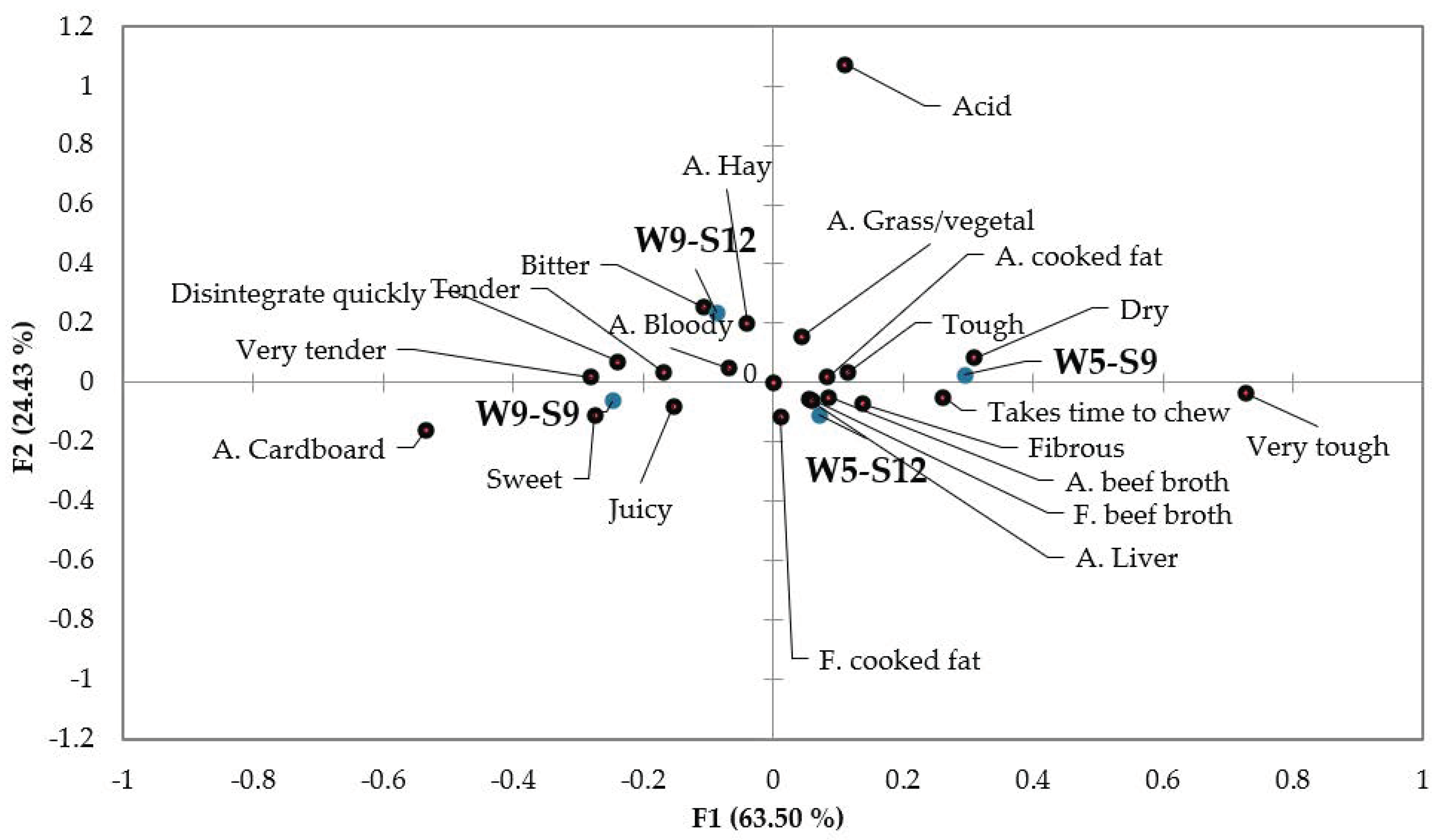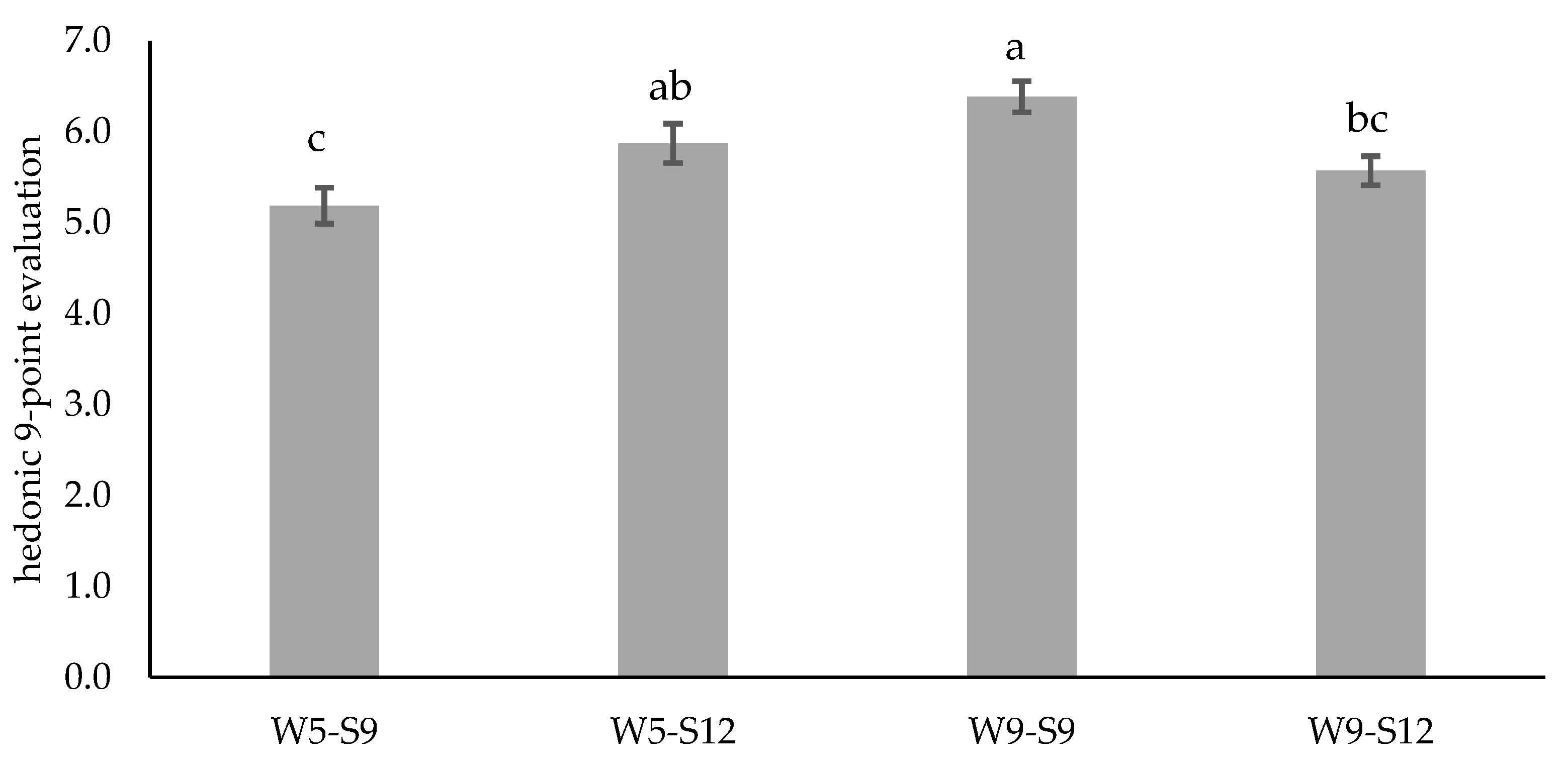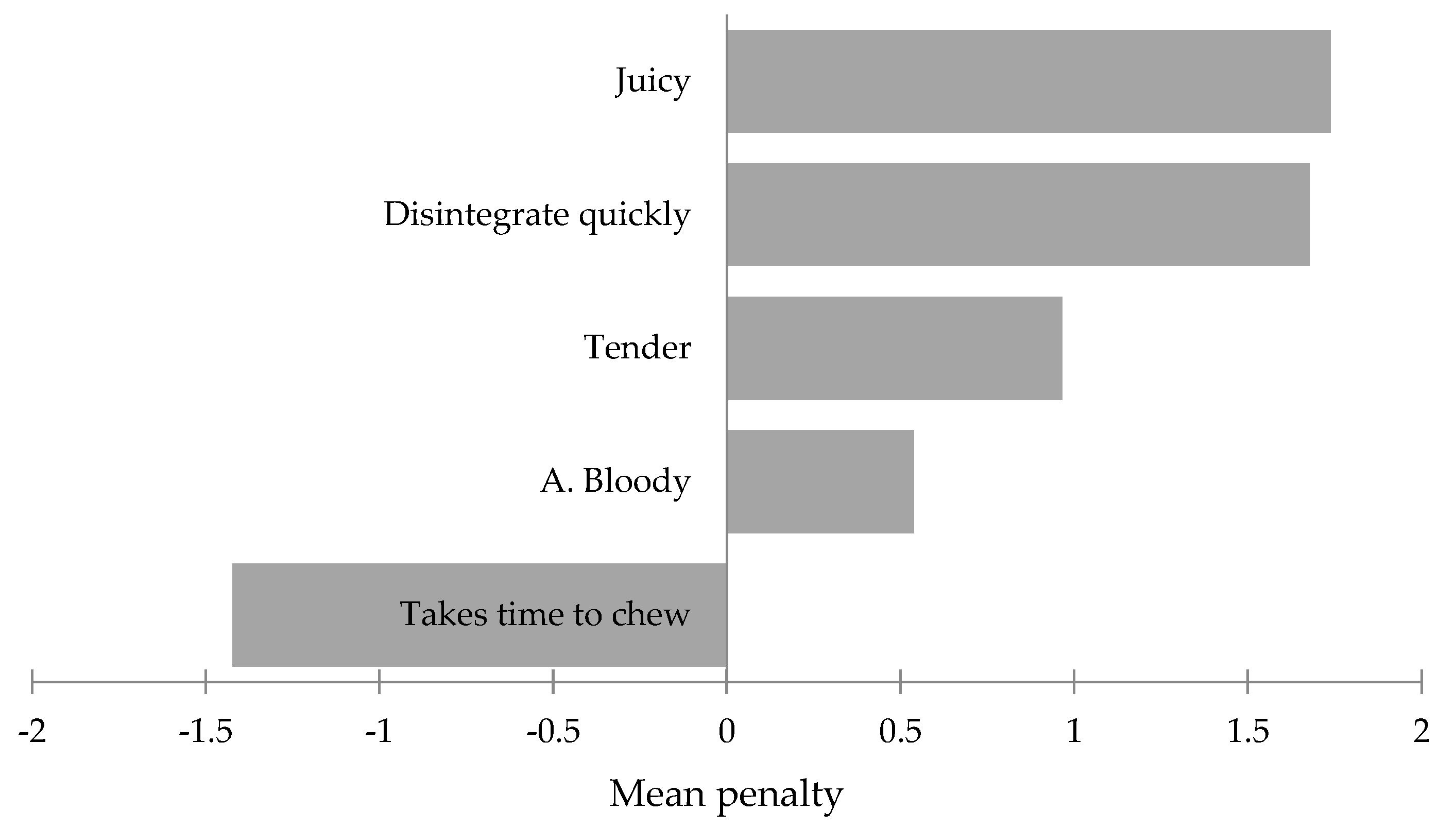The Effect of Weaning and Slaughter Age on the Physicochemical and Sensory Characteristics of Arouquesa Beef—A PDO Portuguese Meat
Abstract
1. Introduction
2. Materials and Methods
2.1. Animals and Samples
2.2. Physicochemical Parameters
2.3. Sensory Analysis
2.4. Statistical Analysis
3. Results and Discussion
3.1. Physicochemical Parameters
3.2. Sensory Analysis
4. Conclusions
Author Contributions
Funding
Institutional Review Board Statement
Informed Consent Statement
Data Availability Statement
Conflicts of Interest
References
- Carrieri, V.; Principe, F. WHO and for how long? An empirical analysis of the consumers’ response to red meat warning. Food Policy 2022, 108, 102231. [Google Scholar] [CrossRef]
- Farvid, M.S.; Sidahmed, E.; Spence, N.D.; Mante Angua, K.; Rosner, B.A.; Barnett, J.B. Consumption of red meat and processed meat and cancer incidence: A systematic review and meta-analysis of prospective studies. Eur. J. Epidemiol. 2021, 36, 937–951. [Google Scholar] [CrossRef] [PubMed]
- IARC Working Group on the Evaluation of Carcinogenic Risks to Humans. Red Meat and Processed Meat; WHO: Geneva, Switzerland, 2018; Volume 114, ISBN 9789283201809.
- Aberman, Y.; Plaks, J. When Less is better: Messages that Present Dietary Carbon Emissions Data at the individual (vs. Aggregate) Level Increase Commitment to Sustainable Beef Consumption. Appetite 2022, 174, 105980. [Google Scholar] [CrossRef] [PubMed]
- Paiva, T.; Jacinto, T.A.; Sarraguça, M.C.; Coutinho, P. Beef Consumers Behaviour and Preferences—The Case of Portugal. Sustainability 2022, 14, 2358. [Google Scholar] [CrossRef]
- Sonoda, Y.; Oishi, K.; Chomei, Y.; Hirooka, H. How do human values influence the beef preferences of consumer segments regarding animal welfare and environmentally friendly production? Meat Sci. 2018, 146, 75–86. [Google Scholar] [CrossRef]
- Hemsworth, L.M.; Rice, M.; Hemsworth, P.H.; Coleman, G.J. Telephone Survey versus Panel Survey Samples Assessing Knowledge, Attitudes and Behavior Regarding Animal Welfare in the Red Meat Industry in Australia. Front. Psychol. 2021, 12, 581928. [Google Scholar] [CrossRef]
- Rice, M.; Hemsworth, L.M.; Hemsworth, P.H.; Coleman, G.J. The impact of a negative media event on public attitudes towards animal welfare in the red meat industry. Animals 2020, 10, 619. [Google Scholar] [CrossRef]
- Schmiess, J.S.; Lusk, J.L. Trade-Off between Animal Welfare and Environmental Impacts of Beef Production: An Analysis of Presentation Effects on Consumer Choice. J. Agric. Resour. Econ. 2022, 47, 278–299. [Google Scholar]
- Ardeshiri, A.; Rose, J.M. How Australian consumers value intrinsic and extrinsic attributes of beef products. Food Qual. Prefer. 2018, 65, 146–163. [Google Scholar] [CrossRef]
- Resano, H.; Sanjuán, A.I. Exploring the role of mountain origin and autochthonous breed on urban consumers’ acceptability. Sustainability 2018, 10, 4423. [Google Scholar] [CrossRef]
- Bispo, E.; Monserrat, L.; González, L.; Franco, D.; Moreno, T. Effect of weaning status on animal performance and meat quality of Rubia Gallega calves. Meat Sci. 2010, 86, 832–838. [Google Scholar] [CrossRef] [PubMed]
- Molina-Flores, B.; Velasco, G.; Loza, S.; Soliman, I. Socio-cultural factors determining roles and responsibilities in traditional cattle production systems within rural communities of Upper Egypt. EAAP Sci. Ser. 2012, 131, 241–248. [Google Scholar]
- Soy-Massoni, E.; Uyttewaal, K.; Prat-Guitart, N.; Varela, E. Fire Eaters: Exploring Consumer Preferences for Labeling Extensive Livestock Products Providing Wildfire Prevention Services. Land 2022, 11, 700. [Google Scholar] [CrossRef]
- Fabbri, M.C.; de Rezende, M.P.G.; Dadousis, C.; Biffani, S.; Negrini, R.; Carneiro, P.L.S.; Bozzi, R. Population structure and genetic diversity of Italian beef breeds as a tool for planning conservation and selection strategies. Animals 2019, 9, 880. [Google Scholar] [CrossRef]
- Oliete, B.; Carballo, J.A.; Varela, A.; Moreno, T.; Monserrat, L.; Sánchez, L. Effect of weaning status and storage time under vacuum upon physical characteristics of meat of the Rubia Gallega breed. Meat Sci. 2006, 73, 102–108. [Google Scholar] [CrossRef]
- CAP/DGAV. Catálogo Oficial de Raças Autóctones Portuguesas; DGAV: Lisbon, Portugal, 2021.
- Melucci, L.M.; Panarace, M.; Feula, P.; Villarreal, E.L.; Grigioni, G.; Carduza, F.; Soria, L.A.; Mezzadra, C.A.; Arceo, M.E.; Papaleo Mazzucco, J.; et al. Genetic and management factors affecting beef quality in grazing Hereford steers. Meat Sci. 2012, 92, 768–774. [Google Scholar] [CrossRef]
- Blanco, M.; Ripoll, G.; Albertí, P.; Sanz, A.; Revilla, R.; Villalba, D.; Casasús, I. Effect of early weaning on performance, carcass and meat quality of spring-born bull calves raised in dry mountain areas. Livest. Sci. 2008, 115, 226–234. [Google Scholar] [CrossRef]
- Moreno, T.; Varela, A.; Oliete, B.; Carballo, J.A.; Sánchez, L.; Montserrat, L. Nutritional characteristics of veal from weaned and unweaned calves: Discriminatory ability of the fat profile. Meat Sci. 2006, 73, 209–217. [Google Scholar] [CrossRef]
- Pateiro, M.; Lorenzo, J.M.; Diaz, S.; Gende, J.A.; Fernandez, M.; Gonzalez, J.; Garcia, L.; Rial, F.J.; Franco, D. Meat quality of veal: Discriminatory ability of weaning status. Span. J. Agric. Res. 2013, 11, 1044–1056. [Google Scholar] [CrossRef]
- Florek, M.; Domaradzki, P.; Stanek, P.; Litwińczuk, Z.; Skałecki, P. Longissimus lumborum quality of Limousin suckler beef in relation to age and postmortem vacuum ageing. Ann. Anim. Sci. 2015, 15, 785–798. [Google Scholar] [CrossRef]
- Eckert, E.; Brown, H.E.; Leslie, K.E.; DeVries, T.J.; Steele, M.A. Weaning age affects growth, feed intake, gastrointestinal development, and behavior in Holstein calves fed an elevated plane of nutrition during the preweaning stage. J. Dairy Sci. 2015, 98, 6315–6326. [Google Scholar] [CrossRef] [PubMed]
- European Union. EU Council Regulation (EC) No 1099/2009 of 24 September 2009 on the protection of animals at the time of killing. Off. J. Eur. Union 2009, 52, 1–30. [Google Scholar]
- Honikel, K.O. Reference methods for the assessment of physical characteristics of meat. Meat Sci. 1998, 49, 447–457. [Google Scholar] [CrossRef]
- Wheeler, T.; Papadopoulos, L.; Miller, R.; Belk, K.; Dikeman, M.; Calkins, C.; King, D.; Miller, M.; Shackeford, S.; Wasser, B.; et al. Research Guidelines for Cookery, Sensory Evaluation, and Instrumental Tenderness Measurements of Meat, 2nd ed.; American Meat Science association: Champaign, IL, USA, 2015. [Google Scholar]
- English, A.R.; Wills, K.M.; Harsh, B.N.; Mafi, G.G.; VanOverbeke, D.L.; Ramanathan, R. Effects of aging on the fundamental color chemistry of dark-cutting beef. J. Anim. Sci. 2016, 94, 4040–4048. [Google Scholar] [CrossRef] [PubMed]
- Jose, C.; McGilchrist, P. Ageing as a method to increase bloom depth and improve retail colour in beef graded AUS-MEAT colour 4. Meat Sci. 2022, 183, 108665. [Google Scholar] [CrossRef]
- Mancini, R.A.; Ramanathan, R. Effects of postmortem storage time on color and mitochondria in beef. Meat Sci. 2014, 98, 65–70. [Google Scholar] [CrossRef]
- Blanco, M.; Villalba, D.; Ripoll, G.; Sauerwein, H.; Casasús, I. Effects of early weaning and breed on calf performance and carcass and meat quality in autumn-born bull calves. Livest. Sci. 2009, 120, 103–115. [Google Scholar] [CrossRef]
- Cho, S.; Kang, S.M.; Seong, P.; Kang, G.; Choi, S.; Kwon, E.; Moon, S.; Kim, D.; Park, B. Physico-chemical meat qualities of loin and top round beef from Holstein calves with different slaughtering ages. Korean J. Food Sci. Anim. Resour. 2014, 34, 674–682. [Google Scholar] [CrossRef][Green Version]
- Nishimura, T.; Hattori, A.; Takahashi, K. Structural changes in intramuscular connective tissue during the fattening of Japanese Black cattle: Effect of marbling on beef tenderization. J. Anim. Sci. 1999, 77, 93–104. [Google Scholar] [CrossRef]
- Pematilleke, N.; Kaur, M.; Adhikari, B.; Torley, P.J. Relationship between instrumental and sensory texture profile of beef semitendinosus muscles with different textures. J. Texture Stud. 2022, 53, 232–241. [Google Scholar] [CrossRef]
- Popoola, I.O.; Bruce, H.L.; McMullen, L.M.; Wismer, W.V. Consumer Sensory Comparisons Among Beef, Horse, Elk, and Bison Using Preferred Attributes Elicitation and Check-All-That-Apply Methods. J. Food Sci. 2019, 84, 3009–3017. [Google Scholar] [CrossRef] [PubMed]
- Zymon, M.; Strzetelski, J. Dietary value and sensory quality of calf meat depending on different n-3 PUFA sources in the diet. J. Anim. Feed Sci. 2007, 16, 555–564. [Google Scholar] [CrossRef][Green Version]
- Revilla, I.; Plaza, J.; Palacios, C. The effect of grazing level and ageing time on the physicochemical and sensory characteristics of beef meat in organic and conventional production. Animals 2021, 11, 635. [Google Scholar] [CrossRef] [PubMed]
- Story, C.E.; Rasby, R.J.; Clark, R.T.; Milton, C.T. Age of calf at weaning of spring-calving beef cows and the effect on cow and calf performance and production economics. J. Anim. Sci. 2000, 78, 1403–1413. [Google Scholar] [CrossRef]
- Therkildsen, M.; Larsen, L.M.; Bang, H.G.; Vestergaard, M. Effect of growth rate on tenderness development and final tenderness of meat from Friesian calves. Anim. Sci. 2002, 74, 253–264. [Google Scholar] [CrossRef]
- Merlino, V.M.; Borra, D.; Girgenti, V.; Dal Vecchio, A.; Massaglia, S. Beef meat preferences of consumers from Northwest Italy: Analysis of choice attributes. Meat Sci. 2018, 143, 119–128. [Google Scholar] [CrossRef]
- Crovato, S.; Pinto, A.; Di Martino, G.; Mascarello, G.; Rizzoli, V.; Marcolin, S.; Ravarotto, L. Purchasing Habits, Sustainability Perceptions, and Welfare Concerns of Italian Consumers Regarding Rabbit Meat. Foods 2022, 11, 1205. [Google Scholar] [CrossRef]
- Napolitano, F.; Caporale, G.; Carlucci, A.; Monteleone, E. Effect of information about animal welfare and product nutritional properties on acceptability of meat from Podolian cattle. Food Qual. Prefer. 2007, 18, 305–312. [Google Scholar] [CrossRef]
- Pala, A.; Atakisi, G. Effects of animal welfare on sensory acceptance scoring of yogurt. J. Appl. Anim. Res. 2012, 40, 305–310. [Google Scholar] [CrossRef]
- Blanc, S.; Massaglia, S.; Borra, D.; Mosso, A.; Merlino, V.M. Animal welfare and gender: A nexus in awareness and preference when choosing fresh beef meat? Ital. J. Anim. Sci. 2020, 19, 410–420. [Google Scholar] [CrossRef]
- Patarata, L.; Carvalho, F.; Fraqueza, M.J. Nitrite-Free Implications on Consumer Acceptance and the Behavior of Pathogens in Cured Pork Loins. Foods 2022, 11, 796. [Google Scholar] [CrossRef] [PubMed]



| Parameters | W5-S9 | W5-S12 | W9-S9 | W9-S12 | p |
|---|---|---|---|---|---|
| pH24h | 5.64 (0.07) | 5.56 (0.05) | 5.63 (0.07) | 5.60 (0.04) | 0.798 |
| L* | 40.18 (2.02) | 41.49 (0.64) | 39.84 (1.48) | 40.37 (2.03) | 0.851 |
| a* | 23.95 (0.97) | 26.29 (0.45) | 23.96 (0.78) | 25.52 (1.41) | 0.140 |
| b* | 7.11 (0.84) | 9.07 (0.36) | 6.83 (0.79) | 8.45 (1.05) | 0.104 |
| Cooking losses (%) | 17.30 (1.82) | 18.32 (0.34) | 17.65 (0.85) | 21.88 (2.93) | 0.198 |
| Shear force (N/cm2) | 87.02 (3.89) b 1 | 64.13 (6.42) ab | 62.47 (5.68) a | 63.47 (8.15) ab | 0.032 |
| Attributes | W5-S9 | W5-S12 | W9-S9 | W9-S12 | p |
|---|---|---|---|---|---|
| Beef broth aroma | 0.53 a 1 | 0.73 b | 0.56 ab | 0.37 a | <0.0001 |
| Cooked fat aroma | 0.19 | 0.14 | 0.19 | 0.10 | 0.289 |
| Beef broth flavour | 0.43 ab | 0.51 b | 0.49 b | 0.27 a | 0.005 |
| Cooked fat flavour | 0.16 | 0.26 | 0.219 | 0.11 | 0.112 |
| Sweet | 0.07 a | 0.20 ab | 0.249 b | 0.11 ab | 0.009 |
| Bitter | 0.06 | 0.09 | 0.09 | 0.10 | 0.750 |
| Acid | 0.04 | 0.00 | 0.019 | 0.07 | 0.069 |
| Tender | 0.23 a | 0.36 ab | 0.46 b | 0.29 ab | 0.017 |
| Very tender | 0.10 a | 0.14 ab | 0.26 b | 0.13 ab | 0.044 |
| Tough | 0.14 | 0.24 | 0.13 | 0.14 | 0.244 |
| Very tough | 0.17 b | 0.10 ab | 0.03 a | 0.03 a | 0.005 |
| Fibrous | 0.19 | 0.29 | 0.17 | 0.13 | 0.112 |
| Juicy | 0.26 a | 0.36 ab | 0.50 b | 0.21 a | 0.001 |
| Dry | 0.24 | 0.26 | 0.11 | 0.16 | 0.087 |
| Disintegrate quickly | 0.19 a | 0.33 ab | 0.46 b | 0.30 ab | 0.006 |
| Takes time to chew | 0.30 | 0.29 | 0.20 | 0.13 | 0.055 |
| Bloody | 0.20 | 0.29 | 0.30 | 0.21 | 0.318 |
| Liver aroma | 0.10 | 0.14 | 0.11 | 0.07 | 0.514 |
| Hay aroma | 0.07 | 0.06 | 0.09 | 0.07 | 0.927 |
| Grass/vegetal aroma | 0.10 | 0.09 | 0.10 | 0.09 | 0.971 |
| Cardboard aroma | 0.01 | 0.04 | 0.10 | 0.03 | 0.081 |
| Fish aroma | 0.00 | 0.00 | 0.00 | 0.00 | 1.000 |
| With Identification | W5 | W9 |
|---|---|---|
| Reduce | 31.4 | 22.1 |
| Improve | 38.6 | 57.1 |
| Maintain | 30.0 | 20.8 |
| Z (p) | −1.791 (0.073) | −3.492 (<0.001) |
Publisher’s Note: MDPI stays neutral with regard to jurisdictional claims in published maps and institutional affiliations. |
© 2022 by the authors. Licensee MDPI, Basel, Switzerland. This article is an open access article distributed under the terms and conditions of the Creative Commons Attribution (CC BY) license (https://creativecommons.org/licenses/by/4.0/).
Share and Cite
Silva, J.A.; Cardoso, R.; Vieira, R.; Almeida, J.C.; Gomes, M.J.; Venâncio, C.; Patarata, L. The Effect of Weaning and Slaughter Age on the Physicochemical and Sensory Characteristics of Arouquesa Beef—A PDO Portuguese Meat. Foods 2022, 11, 2505. https://doi.org/10.3390/foods11162505
Silva JA, Cardoso R, Vieira R, Almeida JC, Gomes MJ, Venâncio C, Patarata L. The Effect of Weaning and Slaughter Age on the Physicochemical and Sensory Characteristics of Arouquesa Beef—A PDO Portuguese Meat. Foods. 2022; 11(16):2505. https://doi.org/10.3390/foods11162505
Chicago/Turabian StyleSilva, José António, Ricardo Cardoso, Raquel Vieira, José Carlos Almeida, Maria José Gomes, Carlos Venâncio, and Luis Patarata. 2022. "The Effect of Weaning and Slaughter Age on the Physicochemical and Sensory Characteristics of Arouquesa Beef—A PDO Portuguese Meat" Foods 11, no. 16: 2505. https://doi.org/10.3390/foods11162505
APA StyleSilva, J. A., Cardoso, R., Vieira, R., Almeida, J. C., Gomes, M. J., Venâncio, C., & Patarata, L. (2022). The Effect of Weaning and Slaughter Age on the Physicochemical and Sensory Characteristics of Arouquesa Beef—A PDO Portuguese Meat. Foods, 11(16), 2505. https://doi.org/10.3390/foods11162505








